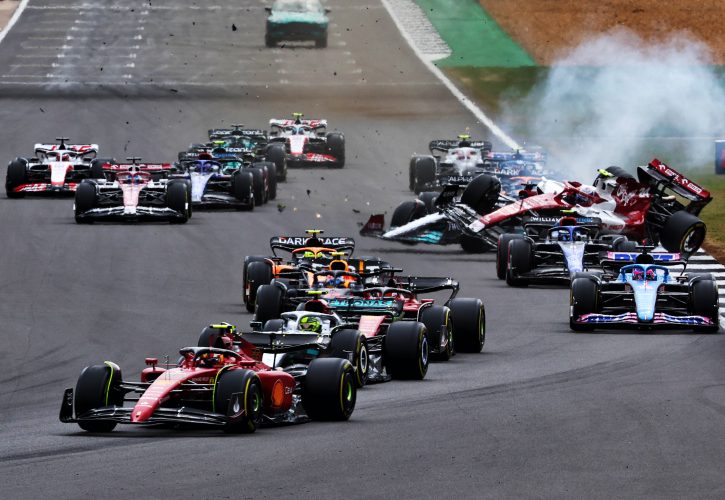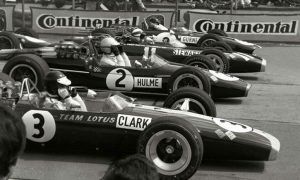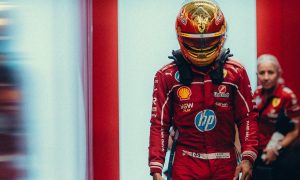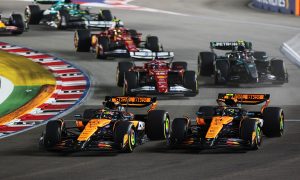
Martin Brundle believes the dramatic start-line crash at Silverstone that involved Zhou Guanyu was triggered by "a mismatch of launch capability" due to drivers staring on different tyre compounds.
Congestion at the start of the British Grand Prix in the middle of the field led to a contact between the AlphaTauri of Pierre Gasly and the Mercedes of George Russell.
The Briton was pitched into Zhou's Alfa which was overturned by the contact and skidded down to the first corner into the gravel trap, where it somersaulted again over the tyre barrier before coming to rest on its side, wedged between the catch fencing and the barrier.
Miraculously, no drivers were injured during the crash and commotion. But Brundle pointed to the disparity in tyre grip as the root cause of the fracas.
"The first corner chaos was very scary for several reasons. In some ways it was one of those ‘I’m surprised that doesn’t happen more often’ crashes as the cars weave their way down to turn one in close formation," commented the former F1 driver in his post-race Sky Sports column.
"It was compounded by the fact that all three available tyre compounds were involved in helping some launch very well, and others like George Russell on the slower hard compound tyre, struggling off the start line.

"From this year the top 10 are no longer obligated to start on their actual qualifying tyres, and so this can lead to a mismatch of launch capability in the front half of the grid as well as the rest of the pack, meaning some are rapidly gaining ground and others falling back.
"Russell appeared to misjudge how far alongside Pierre Gasly was, which is challenging whilst also carefully watching the mayhem ahead and controlling your own car and gearshifts."
While unsurprised by the concertina effect and subsequent mid-grid clash, Brundle was astonished to see Zhou's Alfa overturned as a result of its contact with Russell's Mercedes.
"For his car to then immediately flip over Zhou Guanyu's Alfa Romeo was extraordinary given how low the centre of gravity is on these cars," said Brunlde.
"Large sticky tyres and some momentum can clearly introduce such energy.
"The regulations state that an F1 car and its driver must weigh at least 798 kgs and so on the start line cars fuelled for the race are now over 900kgs.
"Add in a turbinelike 1000 horsepower and, as we witnessed with Romain Grosjean’s fiery accident in Bahrain 2020, there’s a huge amount of energy to contain which circuits are only just about coping with.”
"It was alarming to later see that the rollover structure had broken off altogether but these items can't be infinitely strong otherwise the car would be so heavy, and then everything both on the car and at the crash site would need to be yet stronger again creating a vicious circle. We must lose some weight on the new 2026 cars."

Unfortunately, Alex Albon ended up as collateral damage once the dust from the crash had settled, the Williams bearing the brunt of a head-on impact with the pitwall.
"Another twist was that in the aftermath of the Russell/Zhou contact Alex Albon was turned into the pitwall in his Williams and took a harder hit than Zhou," noted Brundle.
"As ever the spectacular crashes dissipate energy over a much longer period and providing nothing enters into your cockpit then you are less likely to be hurt, such as with my shunt in Melbourne in 1996. It's the sudden stop which really hurts."
Keep up to date with all the F1 news via Facebook and Twitter







